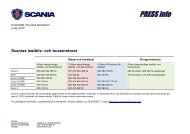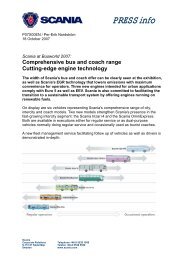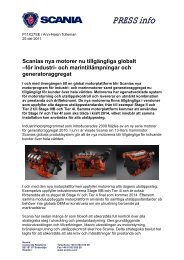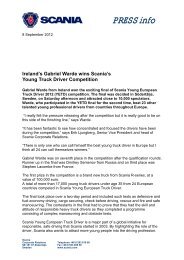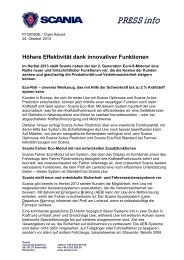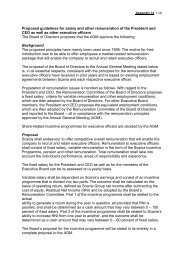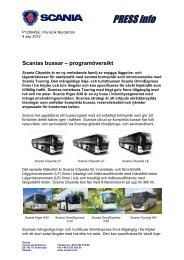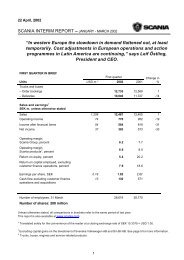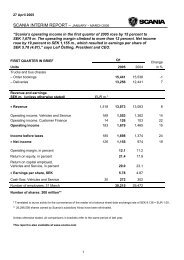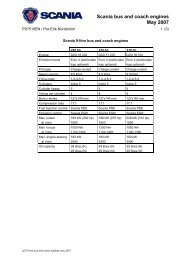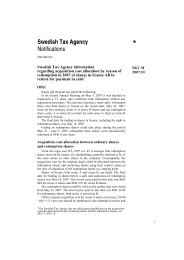Scania Annual Report 2011
Scania Annual Report 2011
Scania Annual Report 2011
You also want an ePaper? Increase the reach of your titles
YUMPU automatically turns print PDFs into web optimized ePapers that Google loves.
78<br />
group financial review<br />
During <strong>2011</strong>, the equity of the <strong>Scania</strong> Group increased by SEK 4,476 m.<br />
and totalled SEK 34,512 m. (30,036) at year-end. Net income added<br />
SEK 9,422 m. (9,103), while the dividend to shareholders decreased<br />
equity by SEK 4,000 m. (800). Equity decreased by SEK 719 m. (1,145)<br />
because of exchange rate differences that arose when translating net<br />
assets outside Sweden. In addition, equity decreased by SEK 306 m.<br />
(461) because of cash flow hedgings and actuarial losses on pension<br />
liabilities. Taxes attributable to items reported under “Other comprehensive<br />
income” totalled SEK 79 m. (36).<br />
The regular dividend for the <strong>2011</strong> financial year proposed by the<br />
Board of Directors is SEK 5.00 (5.00) per share.<br />
NUMBER OF EMPLOYEES<br />
The number of employees in the <strong>Scania</strong> Group at year-end <strong>2011</strong> was<br />
37,496, compared to 35,514 at the end of 2010.<br />
In Vehicles and Services, the number of employees at the end of<br />
December was 36,854 (34,923).<br />
In Financial Services, the number of employees at year-end 2010<br />
was 642 (591).<br />
FINANCIAL RISKS<br />
Borrowing and refinancing risk<br />
<strong>Scania</strong>’s borrowings primarily consist of bonds issued under capital<br />
market programmes, and to some extent of other borrowing mainly via<br />
the banking system. In addition, <strong>Scania</strong> secures a certain portion of its<br />
borrowing needs via four committed credit facilities: two in the international<br />
borrowing market and two in the Swedish market.<br />
At year-end <strong>2011</strong>, borrowings amounted to SEK 38.8 (34.4) billion.<br />
In addition to utilised borrowing, <strong>Scania</strong> had unutilised committed<br />
credit facilities equivalent to SEK 27.9 (27.0) billion.<br />
Interest rate risk<br />
<strong>Scania</strong>’s policy concerning interest rate risks in Vehicles and Services<br />
is that the interest rate refixing period on its net debt should normally<br />
be 6 months, but divergences may be allowed within the 0–24 month<br />
range. In Financial Services the interest rate refixing period on<br />
borrowings shall be matched with the interest rate refixing period on<br />
assets. To manage interest rate risks in the <strong>Scania</strong> Group, derivative<br />
instruments are used.<br />
Currency risk<br />
Currency transaction exposure in operating income during <strong>2011</strong><br />
totalled about SEK 31 (26) billion. The largest currency flows were in<br />
euros, US dollars and Russian roubles. Based on <strong>2011</strong> revenue and<br />
expenses in foreign currencies, a one percentage point change in the<br />
Swedish krona against other currencies would affect operating income<br />
by about SEK 313 m. (258) on an annual basis.<br />
According to <strong>Scania</strong>’s policy, future cash flows may be hedged<br />
during a period that is allowed to vary between 0 and 12 months.<br />
The Board of Directors approves maturities of more than 12 months.<br />
During <strong>2011</strong>, no future currency flows were hedged.<br />
At the end of <strong>2011</strong>, <strong>Scania</strong>’s net assets in foreign currencies<br />
amounted to SEK 16,400 m. (13,150). The net foreign assets of subsidiaries<br />
are normally not hedged. However, to the extent a foreign<br />
subsidiary has significant net monetary assets in local currency, they<br />
may be hedged. At the end of <strong>2011</strong>, no foreign net assets were hedged.<br />
Credit risk<br />
The management of credit risks in Vehicles and Services is regulated<br />
by a credit policy. In Vehicles and Services, credit exposure consist s<br />
mainly of receivables from independent dealers as well as end customer s.<br />
Provisions for credit losses amounted to SEK 516 m. (581),<br />
equivalent to 7.2 (8.0) percent of total receivables. The year’s bad debt<br />
expenses amounted to SEK 92 m. (55).<br />
To maintain a controlled level of credit risk in Financial Services,<br />
the process of issuing credit is supported by a credit policy as well as<br />
credit instructions. In Financial Services, the year’s expenses for actual<br />
and potential credit losses totalled SEK 298 m. (493), equivalent to 0.76<br />
(1.29) percent of the average portfolio. The year’s actual credit losses<br />
amounted to SEK 355 m. (500).<br />
At year-end, the total reserve for bad debt expenses in Financial<br />
Services amounted to SEK 745 m. (817), equivalent to 1.7 (2.2) percent<br />
of the portfolio at the close of <strong>2011</strong>.<br />
The year-end credit portfolio amounted to SEK 42,235 m. (36,137),<br />
allocated among about 24,000 customers, of which 98.4 percent were<br />
customers with lower credit exposure per customer than SEK 15 m.<br />
The management of the credit risks that arise in <strong>Scania</strong>’s treasury<br />
operations, among other things in investment of cash and cash equivalents<br />
and derivatives trading, is regulated in <strong>Scania</strong>’s Financial Policy<br />
document. Transactions occur only within established limits and with<br />
selected, creditworthy counterparties.<br />
financial reports <strong>Scania</strong> <strong>2011</strong>



